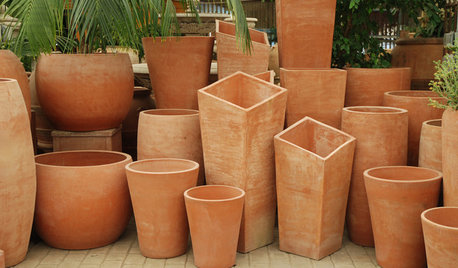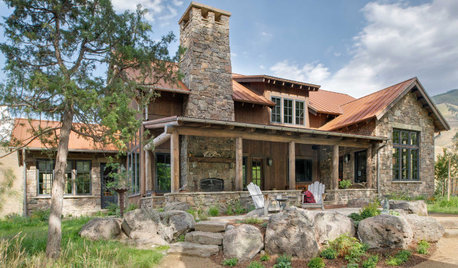Making Terra Preta
Has anyone tried making Terra Preta? and how did you go about it? OR incorporate Charcoal into your soil with good results?
Comments (55)
terran
14 years agolast modified: 9 years agoHi again Len,
Academics relate that slash and burn is a development that was dependant on the introduction of iron/steel axes into the Amazon by Europeans. Slash and Char as the Pre-Columbian Amazonians practiced it worked in a complementary manner within their ecosystem in a form that might be classified as or similar to Permaculture.
Recently, I've been following the biochar group at yahoo. I joined the group in order to view the photos of a homemade retort fabricated by tubjugger, a gardenweb member, who posted to the 'Anyone Using Charcoal' thread. Members of that group are following or active in the development of retorts that range from efficient food cookers to be used in third world situations to high tech / high efficiency units that produce electricity along with combustion products used for industrial applications.
From what I understand, even low tech Terra Preta is carbon negative. Although smoke is released by burning to create the charcoal, plants as part of the Carbon Cycle can recapture that portion, while the charcoal, by one estimate, is locked in the soil for up to 50,000 years. The Amazonian Terra Preta is thought to be between two and five thousand years old and still capable of crop production with little or no additional fertilization.
Charcoal isn't necessary in the soil; it is another way to tinker in the garden for those so inclined. The area I live in southern California, USA is Chaparral and produces a lot of biomass. Usually, the brush is piled and burned without consideration to the production of Carbon dioxide.
I either chip the material and use it for mulch or on pathways after I cut out the larger material that can be used for winter heating in an high efficiency wood stove. I'm still in the process of cleaning up from the October 2007 wildfire and have enough firewood cut to last for years. Nature will take care of the dead material just as it did when the previous wildfire went through 40 years previous; Terra Preta/Biochar would be another complementary use.
Terran
Related Professionals
Ferndale Landscape Architects & Landscape Designers · Graham Landscape Architects & Landscape Designers · Montgomeryville Landscape Architects & Landscape Designers · Forest City Landscape Architects & Landscape Designers · Brentwood Landscape Contractors · Fridley Landscape Contractors · Fuquay-Varina Landscape Contractors · North Chicago Landscape Contractors · Paramus Landscape Contractors · Sammamish Landscape Contractors · Webster Groves Landscape Contractors · Clermont Decks, Patios & Outdoor Enclosures · Green Bay Decks, Patios & Outdoor Enclosures · Randallstown Decks, Patios & Outdoor Enclosures · Statesville Decks, Patios & Outdoor Enclosurestakadi
14 years agolast modified: 9 years agoAn easy way to make "terra preta" is by lighting a pile of organic or yard waste on fire, and then smothering it with water or dirt. A day after, voila, you got charcoal and ash. Whatever is leftover will decompose.
valerie_ru
14 years agolast modified: 9 years agoMay be simple solution is to make small/medium size oven with clay bricks in the garden. Pretty simple construction. Amerindians probably made charcoal this way.
Dan _Staley (5b Sunset 2B AHS 7)
14 years agolast modified: 9 years agoWow. Pre-Columbian origins aside, I'd like anyone in an urban area who got a permit to get anywhere close to actual TP to PM me to tell me how you got a permit for such an operation. Not a burn permit to make an inch of charcoal and giving it a fancy name, but something close to the real thing. Thank you in advance.
Dan
gardenlen
14 years agolast modified: 9 years ago"terran was saying,
Although smoke is released by burning to create the charcoal, plants as part of the Carbon Cycle can recapture that portion,"this is the glass slipper or gossamer suit side the sugar coating of the story, once a person or an action releases carbon into the atmosphere they can't take it back, like they can't take back any discomfort they cause their neighbours "dan", the so called permaculturists over here doing it use that story. like once you start your car you cannot take back the exhaust fumes no matter what you do. like when our countries have those horrendous fires that puts up lots of pollution, it also creates lots of charcoal, i don't see any push to put that sad end to a disaster to some usefull purpose, can imagine the amount of pollution it would create collecting and transporting the stuff to where it is needed.
and on the cleaner side of things i have read much scientific jargon that increases organic matter and compoted soils and muching take up carbon, much like it would in a working bio-diversity forest where a cycle of recycling is a natural part of life.
i can only again ask what is wrong with the gardens i have that i should consider using an incinerator to make something to date that i don't need. the smell of home fires around here in the winter is bad enough.
and on the permaculture side of things the practise would not be truely sustainable and it also takes a lot of energy to amass the material needed, energy imput counts against your output to create productivity and the aim is to produce much, simply without lots of imput over time, so it would be counter productive in that sense.
len
takadi
14 years agolast modified: 9 years ago" like when our countries have those horrendous fires that puts up lots of pollution, it also creates lots of charcoal"
This is called slash and burn, a practice that is as different as night and day to the slash and "smoulder" techniques the Amazonian people used. Only some carbon is released as opposed to most of it. Plus the left over charcoal is a more stable form of carbon, and due to its structure, provides micropores for organisms and nutrients. Even composting releases greenhouse gases.
luckygal
14 years agolast modified: 9 years agoI find the subject of biochar very interesting altho no one knows whether or not modern methods of producing it will be shown to be the same as the way the people of the Amazon did so long ago.
I think the advantage of using biochar is that the fertility of the soil is much longer lasting than anything composting gardeners are doing today.
Also if it can be shown to decrease pollution it will certainly be worthwhile.
takadi
14 years agolast modified: 9 years agoI think it's still debatable whether biochar, as a lasting carbon sequestering agent, is effective or not. The reason why terra preta might have lasted so long could have been due to anaerobic conditions. However, studies have shown that char in conjunction with a fertilizer treatment shows higher yields than just fertilizer alone
Lloyd
14 years agolast modified: 9 years agoVoice of Reason.
An imaginary award I made up in my delusional mind awhile ago that I occasionally bestow upon some people.
Lloyd
gardenlen
14 years agolast modified: 9 years agothanks lloyd now i understand.
might be too high an ward for me all my inspiration comes from common sense and not taking the word of those driven by money as being carte blanche.
enjoy the day
len
gardenlen
14 years agolast modified: 9 years agodoesn't take much of a search to see terra preta in action:
the picture speaks a thousand words.
same as the picture in the folowing link:
words could never describe it hey?
luckygal, all i can say is don't hold your breathe waiting for any reduction of pollution from this avenue.
len
Dan _Staley (5b Sunset 2B AHS 7)
14 years agolast modified: 9 years agoAre we grounded in reality now?Maybe?
Dan
terran
14 years agolast modified: 9 years ago"From what I understand, even low tech Terra Preta is carbon negative. Although smoke is released by burning to create the charcoal, plants as part of the CARBON CYCLE can recapture that portion, while the charcoal, by one estimate, is locked in the soil for up to 50,000 years. The Amazonian Terra Preta is thought to be between two and five thousand years old and still capable of crop production with little or no additional fertilization."
http://www.buzzle.com/articles/the-carbon-cycle-steps.html
The Carbon Cycle Steps
"Carbon is the major constituent of all organic matter, from fossil fuels to DNA that is the genetic basis of all life forms. Let us trace the path of carbon as it constantly moves through various steps of the carbon cycle.
The Carbon Cycle Steps
Carbon is the fourth-most abundant chemical element in the universe and forms the building blocks of the living world along with hydrogen and oxygen. In fact, its concentration in the biotic world (living world) is almost 100 times more than that in the abiotic (non-living) world. Other than this, carbon is an important element that forms a blanket around the earth. It traps the heat of the sun within the atmosphere and hence prevents the earth from freezing. There is a constant exchange of carbon between the biotic and the abiotic world, thus forming a cycle which is called the Carbon Cycle. The carbon cycle plays an important role in maintaining proper levels of carbon in the earth's atmosphere.Steps of the Carbon Cycle
Carbon is regularly being exchanged among the atmosphere, land, water and the living beings. In fact, it is constantly on the move! Let us understand how the carbon cycle works.
* Carbon is removed from the atmosphere: The primary producers (green plants), also known as photoautotrophs are constantly removing carbon dioxide from the atmosphere through the process of photosynthesis (the process in which green plants make food for themselves in presence of sunlight). Certain bacteria, also referred to as chemoautotrophs, use carbon dioxide to synthesize the organic compounds they need.
* Entry of carbon from plants into the animal world: The carbon present in the food made by green plants reaches animals through the food chain. Carnivorous animals receive this carbon when they eat other animals.
* Entry of carbon from atmosphere into the water bodies: Carbon dioxide is continuously being dissolved in the seas and oceans through the process of diffusion. Once dissolved, this carbon dioxide may remain as it is in the marine waters or may get converted into carbonates (CO3-2) and bicarbonates (HCO3-). The carbon dioxide dissolved in water is used by marine plants for photosynthesis. The carbonates are converted into calcium carbonate, by certain marine organisms. This calcium carbonate is used by corals and oysters to make their shells. When these organisms die, their shells deposit on the sea floor and finally turn into sedimentary rocks.
* Carbon moves from living things to the land: As plants and animals die and get buried under the ground, after millions of years, they change into fossil fuels due to high pressure and other physical and chemical changes.
* Carbon returns to the atmosphere: Carbon dioxide is regularly being returned to the atmosphere by the process of respiration in plants and animals. Burning of wood and fossil fuels in industries and automobiles also releases carbon dioxide." ...http://www.buzzle.com/articles/the-carbon-cycle-steps.html
Multi-page explanation of the Carbon Cycle @ NASA Earth Observatory
http://earthobservatory.nasa.gov/Features/CarbonCycle/Hope this helps,
Terran
Dan _Staley (5b Sunset 2B AHS 7)
14 years agolast modified: 9 years agoWhy are we calling the 2 lbs of charcoal left over from burning the brush pile "terra preta'? Is there something I'm missing, or is this some marketing scam?
Dan
gardenlen
14 years agolast modified: 9 years agowith you dan,
it is pie in the sky, gossamer suit stuff, and naturally the false science that supports it, devises its own paramaters to support that hypothosis. it is all educated guessing.
len
terran
14 years agolast modified: 9 years agoTerra Preta - Basic Information
"Terra Preta de Indio" (Amazonian Dark Earths; earlier also called "Terra Preta do Indio" or Indian Black Earth) is the local name for certain dark earths in the Brazilian Amazon region. These dark earths occur, however, in several countries in South America and probably beyond. They were most likely created by pre-Columbian Indians from 500 to 2500 years B.P. and abandoned after the invasion of Europeans (Smith, 1980; Woods et al., 2000). However, many questions are still unanswered with respect to their origin, distribution, and properties.
More follows at
http://www.css.cornell.edu/faculty/lehmann/research/terra%20preta/terrapretamain.htmlThere is more to Terra Preta than charcoal.
The URLs in the post of Jul 11, 09 at 15:13 are informative.
Terran
takadi
14 years agolast modified: 9 years agoGardenlen, it's ironic that you are so passionate against efforts that are at least theoretically carbon NEGATIVE, when mass industries are still setting coal factories that probably produce a thousand times more emissions and pollution and real slash and burn techniques that destroy the forests all over latin america still occur.
This leads me to think that, rather than being a skeptic that demands evidence (both on your side and on theirs...so far the evidence you have displayed is your interpretation of a picture), you are merely a contrarian.
gardenlen
14 years agolast modified: 9 years agotakadi,
the debate is about tera preta is it not, we are not debating coal fired industry or power stations that is yet another story surely. as you say what t/p delivers is but theoretical, i see the one picture of a kiln in brazil or somewhere there, it is in the middle of a forest they appear to be "slashing and burning".
on steep land so once any vegetation is removed to apply the charcaol or grow crops, errosion is all but guaranteed and no charcoal will stop that, the errosion will permanently degrade the land and silt up their in shore fishing grounds and reefs. so until now i have kept within the confines of the debacle sorry debate called terra preta.
and name calling does nothing for your side of the tale.
much of my feelings on those other issues is in my essays.
so far this whole enviornment carbon issue and its fixes are a gossamer suit, in the end the bill the poor will pay won't show any benefit, and rich will get richer as your statesman talking about some inconvenience(and making heaps of cash in the process) who burns more power in his mansion that we could consume in 10 years or more.
read the fine print look behind the picture that is being portrayed, ask what are they realy trying to tell me.
and i still haven't resorted to name calling.
len
Dan _Staley (5b Sunset 2B AHS 7)
14 years agolast modified: 9 years ago"Even if biochar did sequester carbon effectively, which is far from clear, to contribute to mitigating climate change, we would need to char vast quantities of wood and plant matter, a demand that threatens the earth's remaining biodiversity as well as communities living on so-called marginal lands," argues Almuth Ernsting of Biofuelwatch.[4] "Biochar, like other forms of black carbon, actually contributes to warming when it becomes airborne. In one recent Quebec field test, 30% of the biochar dust blew away during transport and as it was being spread over the fields and tilled into the soil.[5] This hasn't been thought through at all." [emphasis added, references omitted]
We must note that biochar must be made in a factory to reduce C emissions into the atmosphere - burning stuff in your backyard isn't helping, IOW. The Life Cycle Analyses inb the factory haven't been done, either.
I think the idea is interesting. And we should follow through. But the touts here are premature.
HTH.
Dan
terran
14 years agolast modified: 9 years agoFrom the link to the post of Wed, Jul 15, 09 at 14:58
"Amazonian Dark Earths have high carbon contents of up to 150 g C/kg soil in comparison to the surrounding soils with 20-30 g C/kg soil (Sombroek, 1966; Smith, 1980; Kern and Kämpf, 1989; Sombroek et al., 1993; Woods and McCann, 1999; Glaser et al., 2000). Additionally, the horizons which are enriched in organic matter, are not only 10-20cm deep as in surrounding soils, but may be as deep as 1-2m (average values probably around 40-50cm)! Therefore, the total carbon stored in these soils can be one order of magnitude higher than in adjacent soils."
Also
"Continuous cropping for longer periods of time appears to be possible from a soil fertility point of view. How long a field can be continuously cropped and what can be done to prolong this period is not yet clear. Petersen et al. (2001) reported that Amazonian Dark Earths in Açutuba were under continuous cultivation without fertilization for over 40 years."
The discussion has veered off topic. Should we start another thread and try to discuss in terms of apples to apples, and oranges to oranges?
Apples could be the study of indigenously created Terra Preta soils (appropriate to the Original Post inquiry?), and oranges the degradation of ecosystems by 'modern' slash and burn agricultural systems to promote the corporate bottom line.
Is it possible to agree that the degradation of ecosystems for short term goals is not a good use of vital global resources. Might those short term goals include destruction of an environment to promote, soy beans for cheap cattle feed, palm oil for bio-fuels etc.?
Is it possible to agree that soil improvement is an acceptable course of study?
Terran
takadi
14 years agolast modified: 9 years agolol, Gardenlen, I'm sorry if I hurt your feelings, but you were acting like a contrarian (at least up until your recent post). It is not name calling, it is simply an observation. If you have evidence that biochar or terra preta does more harm than good, I'd love to see it. Biochar has alot of potential but I don't think anyone is treating it like the "miracle" you accuse people like Dan of perceiving it as
gardenlen
14 years agolast modified: 9 years ago"terran asked,
Is it possible to agree that soil improvement is an acceptable course of study?"can't see why not this debate is about terra preta but. but soil can be improved by recycling waste back into the land that helped produce the product that created the waste in the first place, that is a natural cycle in nature the very cycle that keeps viable bio-diversity forests alive and well. we recyle waste into our gardens it comes from food grown on a farm and ends up feeding our medium it should cycle back to the farm. no good mentioning distance and cost that brings in the issue that farmers need to become community farmers if they are to be sustainable. but again like coal fired industry a whole 'nuther story.
nothing hypothetical or theoretical about that whatsoever.
len
gardenlen
14 years agolast modified: 9 years ago"I don't think anyone is treating it like the "miracle" you accuse people like Dan of perceiving it as"
i think you are trying to put words into my mouth takadi, if anyone is seemingly putting this under a miracle status surely that is you?
my feelings aren't hurt just sad that some need to resort to name calling, other than that it is like water off a ducks back to me i have the right to freedom of speech and opinion same as you do.
like i keep saying look behind the pictures my friend takadi, look at the forest being slashed and burnt look at the issues of land degredation caused by agriculture the world over by slash and burn techniques. look at the pictures study them read between the lines. come outside the square.
len
takadi
14 years agolast modified: 9 years agoGardenlen, I repeatedly have seen you refer to biochar as a "gossamer suit" or a "glass slipper", which I assumed is a synonym for miracle cure. If not, I apologize
As you have stated, there really isn't any empirical evidence that terra preta, or by recent standards, applications of biochar, is a carbon negative practice. It is all theoretical at the moment. Also, there are issues of erosion prevention, what factors contribute to the long lasting effect of terra preta, if there's a bigger picture than just charcoal, and if terra preta is just exaggerated.
Making charcoal, in my personal opinion, is just a drop in the bucket compared to the mass amounts of greenhouse gases being released everyday in modern society. At least since it is known visually that charcoal enhances yield and production of crops, and if people have some extra wood lying around that they might have planned on burning anyway, I don't see the harm. In theory, it works, but you can only know if it works in practice if you actually practice it and see for yourself
Also, I didn't see myself as really name calling, but you have perceived it as such, I also apologize.
takadi
14 years agolast modified: 9 years agoAlso, the leading scientists in the field specifically make a distinction between terra preta burning and "slash and burn". Slash and burn is letting the material oxidize to the point where most if not all of the carbon is released into the atmosphere and all that is left is ash. This leads unsustainable destruction of forests since the freshly burnt forests provides little long term fertility benefit.
On the other hand, though initially burning biochar may release the same pollutants and gases, the "fire" is burned, or rather smoldered in low oxygen environments, thus preventing a large portion of the carbon from oxidizing and releasing into the atmosphere, leaving it in the theoretically stable form of carbon charcoal.
Apparently this charcoal has micropores that allow it to become microscopic "coral reefs" for microorganisms and also are chemically "sticky" like the charcoal filters...the nutrients readily attach themselves to the charcoal, especially water, oxygen, phosphorus, and nitrogen, making it an even more habitable place for microorganisms and root structures.
Apparently, even though terra preta is repeatedly harvested for potting soil, the harvested terra preta eventually replaces itself, as the black soil actually spreads and grows to compensate for its missing components. I haven't read on HOW this happens exactly, but if this isn't evidence of the enhanced microorganism activity in terra preta, I don't know what is.
Now apparently terra preta was created by simply burying the charcoal in the soil, based on recent evidence. If this is the case, and it is proven so, if we can make a case for slash and "char" ala terra preta rather than slash and burn, rainforest destruction can be hindered since farmers will have no more use moving on to new lands after their fields have depleted (which ideally won't happen on biochar lands) and theoretically all the released greenhouse gases can be re-sequestered via the prospect of increased fertility which leads to more plant life.
I just need to distinguish between slash and burn and the terra preta methods because if it works as planned, they are two completely different things and should be recognized that way
valerie_ru
14 years agolast modified: 9 years agoThe most interesting question for me is HOW amerindians made charcoal? Did they make special ovens?
gardenlen
14 years agolast modified: 9 years ago"takadi pointed out,
Gardenlen, I repeatedly have seen you refer to biochar as a "gossamer suit" or a "glass slipper""yes i alluded to the hans christian anderson moralle story of medieval times (the story is displayed on our page) that describes a kingdom/king being relieved of a kings fortune for a suit that was invisible, this scenerio has distinct similarities as at the end of the day the poor will pay for something that won't deliver. but then one must ascribe to the laws of common sense to get the advice in the story.
so with all the pollution that is emmitted in the US you want to add this process in as well(in backyards and refuse tips) to create more, keep in mind that timber used in those incinirators needs to be gathered then it needs to be cut up in suitably sized sections all using man power and chain saws which use fossil based fuels. then the energy by human hand to make the kiln from scratch, then the process so visible to us on those site occurs over some days maybe weeks, then that product has to be shipped to some point that needs it usually using trucks or whatever. lots of carbon and energy has been used.
so if land degredation and what follows is of no concern then go for it.
len
terran
14 years agolast modified: 9 years agoHola todos, (Hello everyone),
Seems that we have decided to hijack snoggerboy's post.
Len,
takadi made the distinction between slash and burn and slash and char, but just found this URL that is interesting. The diagram indicates that there is a net 20% withdrawal of Carbon from the atmosphere when biomass is put through pyrolysis and incorporated into the soil.As I mentioned earlier in this thread, charcoal isn't necessary in the soil; it is another way to tinker in the garden for those so inclined. The area I live in southern California, USA is Chaparral and produces a lot of biomass. Usually, the brush is piled and burned (slash and burn) without consideration to the production of Carbon dioxide. It would be much better if, as a community, we could turn some of this biomass into charcoal and energy production rather than into ash and greenhouse gases.
California recently enacted legislation wherein residents can avail themselves of a service that will chip the branches and the material is then used to generate electricity, but I do not know if the material is burned to ash or put through pyrolysis to create a beneficial byproduct in addition to the electricity.
valerie_ru,From what I've read the Amer-Indians had refuse piles (middens) in and around their villages. I would assume that the smelly trash piles attracted insects and other varmints and became a nuisance, so they were torched. Wet piles of partially composted waste smoldered and created a range of cooked material including charcoal.
This may account for part of the Terra Preta, but I've also seen photos on the internet that depict these improved soils to a depth of six feet (2meters) with broken pottery shards included to that depth that would indicate (at least to me) that the result was a concerted effort.
I haven't seen any explanation as to how these depths were achieved. Were the 'garden' areas dug out and filled or might low lying areas have been filled with refuse repeatedly over time and torched to achieve the objective?
takadi,
"Apparently, even though terra preta is repeatedly harvested for potting soil, the harvested terra preta eventually replaces itself, as the black soil actually spreads and grows to compensate for its missing components. I haven't read on HOW this happens exactly, but if this isn't evidence of the enhanced microorganism activity in terra preta, I don't know what is."I had not heard of this before. Interesting.
----
I suggest that we make the distinction, again, that Terra Preta is more than charcoal. In my own experiments, I have included Effective Microorganisms (EM) with the charcoal, and Bokashi (fermented organic matter) to attempt to replicate the products of a village midden.
URLs
http://www.css.cornell.edu/faculty/lehmann/index.html
http://emrojapan.com/aboutem.phpTerran
Dan _Staley (5b Sunset 2B AHS 7)
14 years agolast modified: 9 years agoWe haven't highjacked the OP's post at all.
o It is clear no more than a handful of gardeners in the West are making Terra Preta (TP), if that many. My guess is zero people are making TP.
o Some people are burning the brush pile and spreading the kg of charcoal, That is not TP.
o As my links upthread show, there is scant evidence that this is beneficial overall.
There! How's that? I doubt anyone in the West is making TP.
Dan
takadi
14 years agolast modified: 9 years agoWell we know that the Amazon has extremely high nutrient and soil erosion due to rainfall, yet the terra preta is still able to maintain its integrity. Perhaps an extremely wet climate is also necessary for those conditions?
terran
14 years agolast modified: 9 years agoDan,
In that the academics are still in the midst of the study of this type of Anthropogenic Soil, you are correct in your doubt. The original post wanted to know if anyone had tried, the procedure and if there were good results.
I'm in the process of incorporating what I've learned into my garden experiments, have incorporated charcoal (see my last post), but doubt that I have the 2000 + years required to complete the experiment to make sure that it is, indeed, a semblance of Terra Preta . Since this is the first season of my experimentation, I can't attest to any 'good' results from the attempt. For the most part, I believe that the OP's questions are not being addressed.
Regardless, that is not why I checked back. I read further into the California legislation that I mentioned and it has not been enacted to date. The bill (AB1300) would authorize "CAL FIRE to develop and implement a fuels reduction program that provides competitive grants or other financial incentives to communities located in the wildland-urban interface or very high fire hazard severity zones to conduct fuel reduction efforts that minimize the risk or decrease the intensity of a wildfire in or around a community." It seems to me that it is more about finding the monies to cut and transport the fuel to a large biomass power plant to generate electricity. There is not a biochar component to it.
It fits into Len's concern in his post of Jul 16, 09 at 15:33 with regard to shipping biofuels. It looks like a missed opportunity. Oh well, It seems another letter to a legislator relating to Biochar is in order.
----
I think that it needs to be said, again, that there is a distinction between the production of ash from wood, and, or organic matter and the production of biochar, or charcoal. Some how the distinction is being missed by some.
Terran
terran
14 years agolast modified: 9 years agoAre we burnt/charred out? If not here is a link with many more links to to push one over the edge and into the fire.
http://links.org.au/node/1060/19496
More later,
Terran
Dan _Staley (5b Sunset 2B AHS 7)
14 years agolast modified: 9 years agoThanks, we all know about TP and how you think it is great. We just don't live for centuries. And 9/10 of us can't get a permit from the AQ authority to burn for months.
Thanks!
Dan
takadi
14 years agolast modified: 9 years agoAbsence of evidence doesn't equate to evidence of absence
terran
14 years agolast modified: 9 years agoDan,
You don't have to wait to experiment if you don't want. On one of the past Terra Preta threads, here at GardenWeb, someone mentioned Cowboy Charcoal. It is available at Lowe's.
Also, I thought that you mentioned somewhere on these forums that you live on the front range of the Rocky Mountains. If that is correct and you are of a mind, a Biochar convention is to be held in Boulder, CO in August. If interested, let me know and I'll attempt to locate the particulars.
Len,
RE: your post of Jul 14, 09 at 20:04
I suspect that the smoke in the photos that you reference is from the early stages of the process. The ports in the retort, I expect, were plugged a short time later so that the fuel would turn into charcoal and not ash. From my college training as a photographer, I'd consider a photo of a kiln in the woods without the 'action' of the smoke to not lend much appeal to the text.
The photos of the Terra Preta Pot(mentioned in the post of Jul 11, 09 at 15:13) show, on a small scale, the later biogas burning stages of the process. The photos have good detail. It is unfortunate that the other links on the site are not 'up'. http://terrapretapot.org/
From the text of the first link Jul 14, 09 at 20:04
: "Stephen Joseph of Biomass Energy Services and Technology in New South Wales has built a number of char-producing machines in Australia that work at fairly large scales (the models have grown from an original Piglet
through a larger Daisy to a positively bullish El Toro). Joseph looks for companies with a waste problem such as a paper mill with spare scraps or a dairy with old bedding and manure, and then integrates char production into the business so that the heat produced in pyrolysis is used where the firm needs it."Char units that are scaled to the needs of particular operations would take the fuel for long haul transport of biomass to a regional facility out of the equation that we had considered to be a problem with respect to large scale production of Biochar.
Terran
gardenlen
14 years agolast modified: 9 years agog'day terran,
at the end of the day smoke is smoke, and at the end of the day smoke is pollution, even if they do seal the unit off when they open it more gases though invisible will escape just has too hey. no white wash will change slash and burn sorry slash and smoulder (smoulder is an action of burning) technology, and should they build a big enough unit in some spot to make enough material to fill a longhaul semi-trailer vehicle that is going to mean the amassing of huge amounts of slashed trees, and the action of those trees being gathered further and further away requiring transport and man power to get it to the processing point.
end result more carbon in the atmosphere and less bio-diversity habitat, with increased land degredation/errosion and spoilage of inshore reefs.
no amount of white-wash will cover the tarnished black of this process a process that is not necessary.
the pictures do speak a thousand words.
len
Dan _Staley (5b Sunset 2B AHS 7)
14 years agolast modified: 9 years agoAbsence of evidence doesn't equate to evidence of absence
If this contexteless and unreferenced phrase is in reply to my comment above, it makes zero sense in context. Thanks!
----------
Again, for the sixth or twelfth time, charcoal is not Terra Preta, fer chrissake. It's not hard to understand. Charcoal is not terra preta. The answer for the OP: no one. Let's recap: charcoal is not TP.
I'm willing to wager Terra preta is not done in any urbanized area in the US, UK, or western Europe. Or Asia.
And I've already addressed the issues with biochar above (which is not terra preta either), but I guess that won't stop the addled and ill-conceived ideological campaign. Let's recap: biochar is not terra preta.
Let us know, terran - since you are obviously 100% committed to walking the walk on this campaign - when your AQ authority approves your permit for cutting down 2-3 hectares for your 150 m2 plot, and what your carbon tax is on that huge net carbon emission, and continuing tax on your children until the ROL(ogging) is paid.
Sheesh.
Dan
terran
14 years agolast modified: 9 years agoHi Dan,
I haven't heard of any responsible person or company that advocates the reduction of the worlds forests to attempt to reproduce Terra Preta. They are speaking of the use of residue from existing agricultural/industrial production.
From the post of Mon, Jul 20, 09 at 5:08
"Joseph looks for companies with a waste problem such as a paper mill with spare scraps or a dairy with old bedding and manure, and then integrates char production into the business so that the heat produced in pyrolysis is used where the firm needs it."
The same is true of the company Eprida, which was also a focus of the article that Len supplied.
The Cowboy Charcoal that has been mentioned and, at least, that I have purchased is made from mill ends of oak flooring.
As to the fact that charcoal is not Terra Preta, I've made the same point on the Terra Preta threads here at GardenWeb, and in particular this thread. Please see the post of Thu, Jul 16, 09 at 15:47
"I suggest that we make the distinction, again, that Terra Preta is more than charcoal. In my own experiments, I have included Effective Microorganisms (EM) with the charcoal, and Bokashi (fermented organic matter) to attempt to replicate the products of a village midden."
Len,
Other than the carbon sequestration information that has been posted in links or as URLs on this thread, I haven't come across any other numerical study related info, yet, relating the smoke/combustion products. I'll keep looking. Let me know if you find anything.
Terran
terran
14 years agolast modified: 9 years agoRE: Anecdotal Evidence
It seems the Anecdotal Evidence page won't link directly. Look on the menu on the left hand side of the page that comes up to find it.
Terran
valerie_ru
14 years agolast modified: 9 years agoI wonder is wood from forest a problem? I have a forest near my home, young forest with a lot of dry trees. They are dry just because the lack of sunlight-other trees are happier in competition. Reasonable cutover of forest is good thing and unlimited source of wood and then charcoal. Charcoal in old times was made instead of coal. It was used for house-warming and steel industry in such townes like London. I can imagine how much charcoal was made there. Mountains!
terran
14 years agolast modified: 9 years agoHi Valerie,
Sustainable coppicing, and, or woodland management is not a problem. Some believe that those interested in BioChar/Terra Preta advocate clear cut styles of forestry to produce char.
I mentioned that I live in Chaparral. There is a constant die off of branches in Ceanothus, Sumac, scrub oak and other plant material that can be turned into BioChar if desired.
Terran
snoggerboy
Original Author14 years agolast modified: 9 years agoBut....How have YOU gone about replicating TP?
I have tried putting Char into my soil (I made and ground to +/-3-10mm size), Terra cotta in the form of rough Brick broken up. Then I included a LOT of Compost, Bone Meal some eggshells, Vermiculite(just a little), handfull of lime, some coco peat, and a bit of well composted manure
The results were very good growing Spinach, Sweet potato , Pak Choy and Chard. Have some lettuce and Cabbage on it now.
This year will be the second year on it and I hope it will improve.
I soak the Char in EM sometimes and add some to our compost .
Anecdotal evidence = an area where "rubbish" and "weeds" were thrown has burnt a couple times and it is the lushest part of the property.
The char really does seem to enhance the fine growth of roots as I found when pulling some sweet potatoes.
Anyone with some results?gardenlen
14 years agolast modified: 9 years agog'day snoggerboy,
yep where you can add in charcoal is is going to be of a help for most of us that is due to accident more than planning, also simply recycling all organic matter through the growing area will give the same results for the plants, and no smoke or fire needed.
coppicing a pristene forest simply won't work as damage to other plant life and soil compaction/errosion will rule supreme and the forest will suffer anyway. but those who are advocating slash and burn are talking clear fell scorched earth.
also as it is over here and be no different anywhere else, collecting piles of felled timber even for chipping/charcoaling purposes won't happen as this is a much more labour intensive process it is easier for those who have the desire to simply cut it all down and take what they want(so this char charcoal whatever issue will add another wonton waste along with wood chipping our forest this adds in). anything else will add to their cost. over here the trucks for the chip factory drive past pliles of dead felled trees but they aren't interested so eventually these trees get burn where they lay.
and in a viable bio-diversity forest any plant/tree that dies should be left there as it becomes part of the recycle process and also becomes habitat for fauna that lives there.
also in slash and burn process i figure the twigs and leaves are discarded to serve no purpose. don't think we need anymore reasons to have our forests decimated.
and carbon sequencing well that's another furphy, think it out, if we throw money at something it will go away? not holding me breathe on this one either.
len
snoggerboy
Original Author14 years agolast modified: 9 years agomethinks, Why the terra cotta shards found so deep in TP and original terra prets should have had a lot of earthworms....then as Darwin thought... that earthworms may be resonsible for digging
and maybe the Maya had terracotta chamber pots....valerie_ru
14 years agolast modified: 9 years agoIndians, I think, made kilns from clay of special design.
Large temporary kilns could produce heat during long time, say month. They were charged only once with wood and then chimney had been closed, so it worked without smoke long time.
I think now how to make such a kiln from the clay.idaho_gardener
14 years agolast modified: 9 years agoI'm looking around for some barbecue charcoal that I can run through my chipper/shredder. I'm hoping to find some cheap stuff, maybe the dollar store will have something that doesn't have a petroleum started in it.
planatus
14 years agolast modified: 9 years agoHere's a new backyard report that just got posted, using winter squash grown in a biochar pit.

















terran